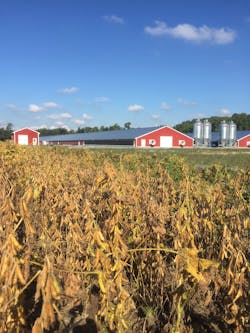Outside the big cities, there is a whole crop of security applications ready to be harvested by security dealers. Modern farms are far from the idyllic pastoral scenes in a child’s storybook. Most farm operations are million-dollar businesses with multiple outbuildings, sizable ledgers of equipment, and a vast expanse of property to protect. Cattle still get rustled today — and the rustlers are high-tech.
Farmers are aware of the danger. Many welcome a chance to provide some security for both their business and their family. It is simply a matter of knowing what a farmer or rancher needs to protect.
Emerging Market and Technologies
An integrator will find a two-fold challenge in agriculture. The typical one is protecting the wide-spread property. The other is providing a security inventory for the farm owner. As with urban business security, video systems are increasingly popular. Biosecurity — especially in the huge poultry houses across the South and along the Eastern seaboard — is a hot new area.
There is not much difference selling security to a farmer than any other businessman, says Steve Flaherty, owner of Agralarm, Crisfield-Pocomoke City, Md. Flaherty has been involved with poultry and livestock since childhood. The son of a large-animal veterinarian, he started his career with a security firm that decided livestock operations were too dusty and stank. They were willing to provide monitoring services if Flaherty’s team would handle the dirty farm work.
“The sale is no different,” Flaherty says. As a Verizon partner, they set up Internet and remote connectivity between farm buildings.” Currently, they provide security for about 1000 farms, and he says his biggest challenge is convincing famers that they need a better quality system than they can get at Walmart. “Good video is not cheap,” says Flaherty, who adds that he generally uses Sony, Axis and Digital Watchdog surveillance equipment.
Video surveillance is certainly a handy tool for farmers — not only does it watch for bad guys, but it also provides a monitoring tool for cows or ewes about to give birth. “This is a ROI (return on investment) type sale to farmers,” explains Chris Sobchuk, president of Allen Leigh Security & Communications of Manitoba, Canada. “The systems save calves, and that puts money in their pockets.”
Allen Leigh started providing wired and wireless video and audio products for farmers so they could monitor their cattle during the calving season. This in-house offering quickly expanded to allow farmers to monitor other areas of their operations. The firm provides wireless video monitoring, alarm systems, farm security systems, two-way radios, surveillance cameras, digital video recorders, drive way alarms, temperature alarms, implement cameras, and wired/wireless video and audio equipment.
An Attractive Target
Even a city boy knows the names of the big four brands preferred by equipment thieves: John Deere, Kubota, Bobcat and Caterpillar. Crooks steal more mowers and garden tractors than anything else, with wheeled and tracked tractors coming in second.
Other theft is just odd. It is not uncommon, when scrap copper prices are high, for a crook to pull the cables off a big center-pivot irrigation system, stealing a half-mile of heavy cable.
Police classify both stolen livestock and equipment as stolen property. Recovery rates for all classes of stolen property are very low. “In 2014, only 23 percent of heavy equipment reported stolen was recovered,” says Ivan Black, director of vehicle operations and investigations for the National Crime Insurance Bureau.
In late July, a Nebraska rancher had 500-plus head of cattle stolen. That’s a loss of more than $750,000 that might have been prevented by a good security audit and system. The Texas and Southwestern Cattle Raisers Association point to the theft of 1,121 head of cattle from an operation near Follett, Texas in March as one of the bolder thefts of late. The animals weighed about 500 pounds each — so it would have taken at least 30 semi-loads to rustle the herd. The producer’s losses exceeded $1 million.
According to the Oklahoma Department of Agriculture, cattle thefts cost state ranchers about $4.5 million last year. California’s Bureau of Livestock Identification reported that 1,100 head of cattle were stolen in that state, with a value of nearly $1 million.
Perhaps those farmers and ranchers would not have had such losses had they monitored their herds. Allen Leigh’s equipment monitoring cameras, while not IP, use a white LED instead of infrared, which gives the farmer ability to see color in complete darkness. “These systems are used for live viewing only and not typically recorded,” Sobchuk notes.
Flaherty finds that many poultry companies require alarm systems. Most broiler farmers are contract growers for a big outfit like Perdue. Those companies will not put chickens in a chicken house if there is not an alarm to monitor environmental conditions.
Forget the old cowboy classics where a scruffy guy in a black hat gets strung up for stealing a few head of cattle. Today’s rustlers are slick and high-tech. Some states, such as Missouri — a big cow-calf state — make it even easier to traffic in stolen livestock by not having a brand law. Since cattle auctions are not required to verify ownership of unbranded cattle, thieves can turn stolen livestock into fast cash.
It is not all million-dollar losses. Farm shops are favored targets for thieves and sometimes the rip-off is little more than petty theft. Generators and hand tools are popular among thieves; in fact, one of Flaherty’s most recent sales was to a North Carolina farmer who had a Bobcat and some tools stolen.
Technology & Installation Considerations
It is increasingly common to have farmers request video surveillance systems. “Personally, I like to see trail cams so that you can watch who is coming and going on roads and paths,” says Jim Drummond, a Nationwide risk management consultant. He suggests farmers purchase HD video cameras so that they or law enforcement can easily pick out faces and license plate numbers on their monitors.
Paul Muskoss, is an owner of CompCam, a Boetineau, N.D., security firm that frequently installs surveillance systems on farms. He agrees with Drummond and Flaherty about choosing HD. “All our cameras are either 2- or 3-megapixel models,” he says. “They deliver four times the digital data for far clearer images than standard cameras do.”
Muskoss also prefers wireless, digital cameras to wired models. “It really saves a lot of time and money spent on trenching cables,” he says. When he does install wires, he always runs them through conduit to protect them against the weather and possible tampering.
“I also mount cameras from 20 to 30 feet up in the air, to make them difficult to reach,” Muskoss adds. He places them on the corners of buildings to afford maximum views. For a north-facing garage, Muskoss mounts two cameras in front, one on the northeast corner and the other on the northwest corner. The cameras are equipped with 2.8 mm to 12mm focal lenses. That means the lenses can provide both wide-angle and telescopic views.
Farms applications benefit from some special features. On Allen Leigh’s camera systems, cables have a 4-in-1 design. Instead of running four cables to the back of the equipment, it is just one cable. Air seeder tank cables save the user from jeopardizing the air seal integrity of the air carts. They are cold-weather hardy.
In terms of maintenance, the only real problems Muskoss has had with his cameras have been with spider webs and, on cattle operations, flies. In general, though, cattle operations do not have to clear lenses until a full year after mounting. Adverse weather can sometimes cloud views. “Some of the lenses come equipped with windshield wipers and others have heaters,” he says.
Allen Leigh’s transmitters are weatherproof, with optional RS485, large 27X analog and 12X digital IR PTZ camera and transmitters.
Curt Harler is a technology writer and is a regular contributor to SD&I magazine. Email him at [email protected]. David Weinstock is a freelance writer and photographer specializing in farm, computer and financial topics.





